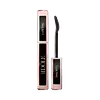What's inside
What's inside
 Key Ingredients
Key Ingredients

 Benefits
Benefits

 Concerns
Concerns

 Ingredients Side-by-side
Ingredients Side-by-side

Water
Skin ConditioningPropylene Glycol
HumectantStyrene/Acrylates/Ammonium Methacrylate Copolymer
Polyurethane-35
Cera Alba
EmollientSynthetic Fluorphlogopite
Glyceryl Stearate
EmollientCetyl Alcohol
EmollientPEG-200 Glyceryl Stearate
Ethylenediamine/Stearyl Dimer Dilinoleate Copolymer
Skin ConditioningCopernicia Cerifera Cera
EmollientStearic Acid
CleansingPalmitic Acid
EmollientEthylene/Va Copolymer
Emulsion StabilisingAlcohol Denat.
AntimicrobialCamellia Sinensis Leaf Extract
AntimicrobialParaffin
PerfumingGlycerin
HumectantSodium Laureth Sulfate
CleansingMyristic Acid
CleansingAminomethyl Propanediol
BufferingDisodium EDTA
Hydroxyethylcellulose
Emulsion StabilisingCaprylic/Capric Triglyceride
MaskingCaprylyl Glycol
EmollientTetrasodium EDTA
Xanthan Gum
EmulsifyingButylene Glycol
HumectantPentaerythrityl Tetra-Di-T-Butyl Hydroxyhydrocinnamate
AntioxidantPotassium Sorbate
PreservativePhenoxyethanol
PreservativeCI 77499
Cosmetic ColorantWater, Propylene Glycol, Styrene/Acrylates/Ammonium Methacrylate Copolymer, Polyurethane-35, Cera Alba, Synthetic Fluorphlogopite, Glyceryl Stearate, Cetyl Alcohol, PEG-200 Glyceryl Stearate, Ethylenediamine/Stearyl Dimer Dilinoleate Copolymer, Copernicia Cerifera Cera, Stearic Acid, Palmitic Acid, Ethylene/Va Copolymer, Alcohol Denat., Camellia Sinensis Leaf Extract, Paraffin, Glycerin, Sodium Laureth Sulfate, Myristic Acid, Aminomethyl Propanediol, Disodium EDTA, Hydroxyethylcellulose, Caprylic/Capric Triglyceride, Caprylyl Glycol, Tetrasodium EDTA, Xanthan Gum, Butylene Glycol, Pentaerythrityl Tetra-Di-T-Butyl Hydroxyhydrocinnamate, Potassium Sorbate, Phenoxyethanol, CI 77499
Isododecane
EmollientCera Alba
EmollientCopernicia Cerifera Cera
EmollientDisteardimonium Hectorite
StabilisingCI 77499
Cosmetic ColorantWater
Skin ConditioningAllyl Stearate/Va Copolymer
Oryza Sativa Cera
Skin ConditioningParaffin
PerfumingAlcohol Denat.
AntimicrobialPolyvinyl Laurate
Vp/Eicosene Copolymer
Propylene Carbonate
SolventTalc
AbrasiveSynthetic Beeswax
Emulsion StabilisingCandelilla Cera
EmollientPEG-30 Glyceryl Stearate
EmulsifyingPanthenol
Skin ConditioningEthylenediamine/Stearyl Dimer Dilinoleate Copolymer
Skin ConditioningBHT
AntioxidantPentaerythrityl Tetra-Di-T-Butyl Hydroxyhydrocinnamate
AntioxidantMethylparaben
PreservativePropylparaben
PreservativeIsododecane, Cera Alba, Copernicia Cerifera Cera, Disteardimonium Hectorite, CI 77499, Water, Allyl Stearate/Va Copolymer, Oryza Sativa Cera, Paraffin, Alcohol Denat., Polyvinyl Laurate, Vp/Eicosene Copolymer, Propylene Carbonate, Talc, Synthetic Beeswax, Candelilla Cera, PEG-30 Glyceryl Stearate, Panthenol, Ethylenediamine/Stearyl Dimer Dilinoleate Copolymer, BHT, Pentaerythrityl Tetra-Di-T-Butyl Hydroxyhydrocinnamate, Methylparaben, Propylparaben
 Reviews
Reviews

Ingredients Explained
These ingredients are found in both products.
Ingredients higher up in an ingredient list are typically present in a larger amount.
Alcohol Denat. is an alcohol with a denaturant property. It is created by mixing ethanol with other additives.
This ingredient gets a bad rep because it is irritating and drying - mostly due to its astringent property. Astringents draw out natural oils in tissue, constricting pores and leaving your skin dried out.
However, alcohol denat. is not all that bad.
Due to its low molecular weight, alcohol denat. tends to evaporate quickly. One study on pig skin found half of applied alcohol evaporated in 10 seconds and less than 3% stayed on skin.
This also helps other ingredients become better absorbed upon application.
Studies are conflicted about whether this ingredient causes skin dehydration. One study from 2005 found adding emollients to propanol-based sanitizer decreased skin dryness and irritation. Another study found irritation only occurs if your skin is already damaged.
Small amounts of alcohol are generally tolerated by oily skin or people who live in humid environments.
The rule of thumb is if this alcohol is near the end of an ingredients list, it will probably not affect your skin much.
Also...
This ingredient has antimicrobial and solvent properties.
The antimicrobial property helps preserve products and increase their shelf life. As a solvent, it helps dissolve other ingredients.
Other types of astringent alcohols include:
Learn more about Alcohol Denat.Cera alba is beeswax, or the wax used by bees to make honeycombs. It is a texture-enhancer and emollient. A study from 2003 found beeswax to be a stronger emollient than ingredients such as petroleum jelly.
As an emollient, beeswax helps hydrate the skin by creating a barrier on top. This barrier traps moisture in.
Emulsifiers help prevent ingredients from separating. This helps create consistent texture.
The structure of beeswax is mainly long-chain alcohols and the esters of fatty acids.
There are three types of beeswax: yellow, white, and absolute. Yellow is pure beeswax taken from the honeycomb. White beeswax is created by filtering or bleaching yellow beeswax. Absolute beeswax is created by treating beeswax with alcohol. Beeswax used in cosmetics are purified.
Beeswax has been used throughout history and even in prehistoric times. Some common uses for beeswax still used today are making candles, as a waterproofing agent, and polish for leather.
Learn more about Cera AlbaCi 77499 is also hydrated iron III oxide. It is created from mixing red and black iron oxides. This helps give shades of darkness to a product.
Iron III oxides are classified as inorganic chemicals for coloring.
This ingredient comes from a palm tree native to Brazil. This ingredient is used to thicken texture and leaves behind a film when applied.
Ethylenediamine/Stearyl Dimer Dilinoleate Copolymer isn't fungal acne safe.
Paraffin is a solid created from petroleum. The term 'paraffin' can also refer to either
petroleum jelly or mineral oil.
It has natural occlusive properties which can worsen oily skin. Due to its petrolatum base, this ingredient is not fungal-acne safe.
Pentaerythrityl Tetra-Di-T-Butyl Hydroxyhydrocinnamate (long name, huh?) is a synthetic antioxidant.
It is used to help stabilize other antioxidants or prevent the color from changing in a product.
As an antioxidant, it helps fight free-radical molecules. Free-radical molecules are capable of damaging our cells and other genetic material. Thus, antioxidants may reduce the signs of aging.
This ingredient is oil-soluble.
Learn more about Pentaerythrityl Tetra-Di-T-Butyl HydroxyhydrocinnamateWater. It's the most common cosmetic ingredient of all. You'll usually see it at the top of ingredient lists, meaning that it makes up the largest part of the product.
So why is it so popular? Water most often acts as a solvent - this means that it helps dissolve other ingredients into the formulation.
You'll also recognize water as that liquid we all need to stay alive. If you see this, drink a glass of water. Stay hydrated!
Learn more about Water